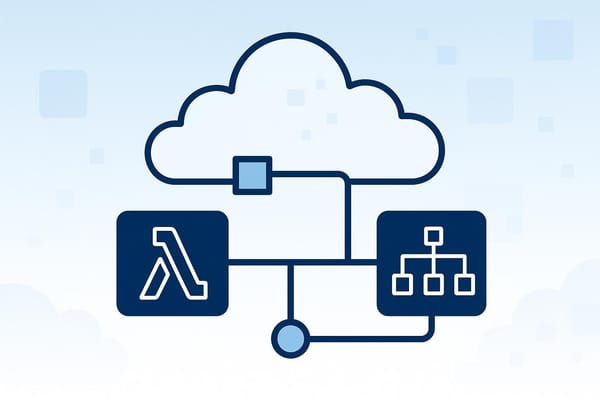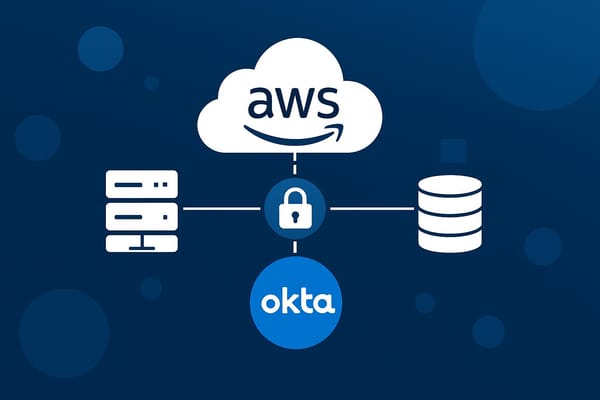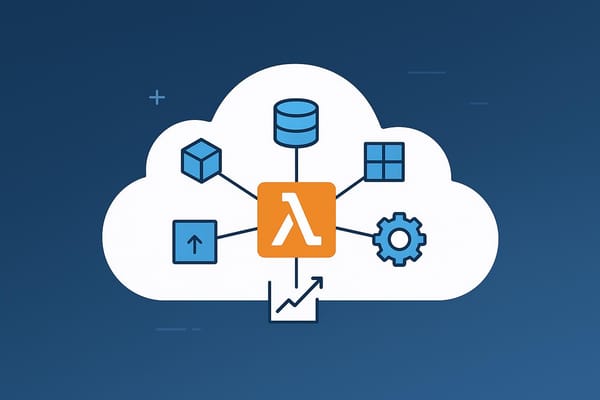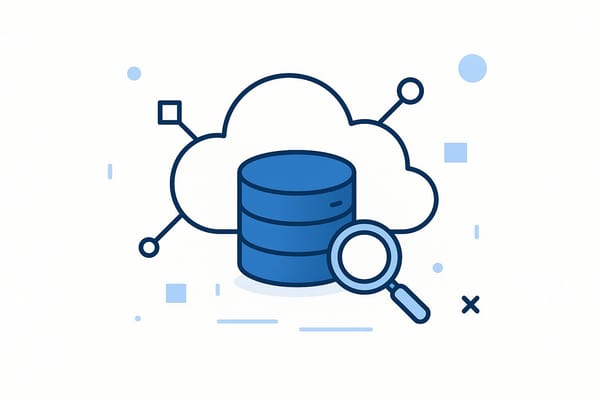Checklist for Scaling Batch Jobs on AWS
Optimize your AWS batch jobs with a comprehensive checklist to enhance performance, control costs, and ensure security.
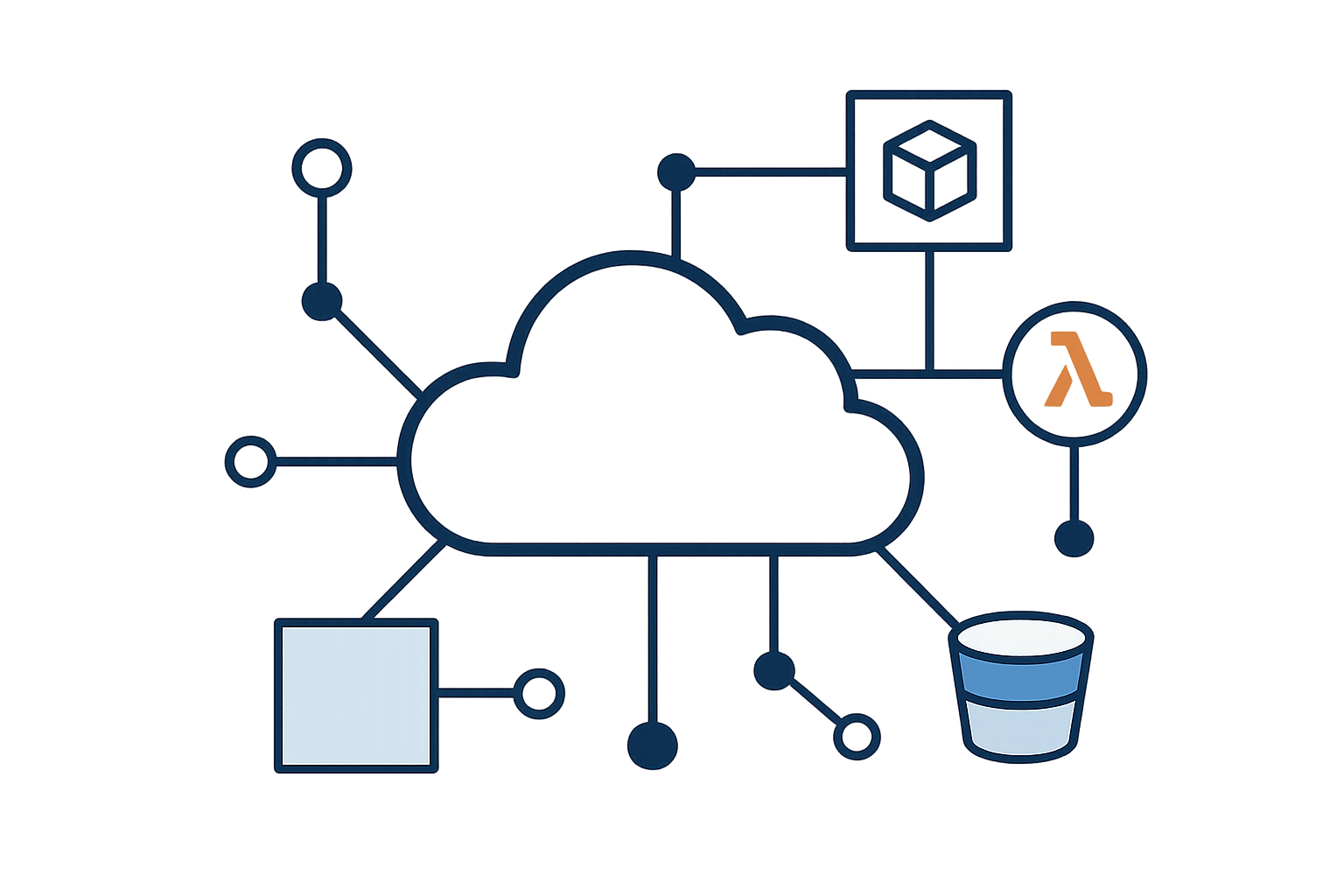
Scaling batch jobs on AWS can be challenging, but it doesn’t have to be. Here’s a quick summary of the steps you need to take to optimise performance, control costs, and secure your environment:
- Review Your Current Setup: Check job queue performance, resource limits, and SLA compliance.
- Set Up Compute Environments: Use multiple Availability Zones, Spot Instances for cost savings, and choose the right instance types.
- Define Batch Job Parameters: Configure retries and backoff delays to handle failures efficiently.
- Enable Auto-Scaling: Monitor key metrics like vCPU utilisation, queue depth, and memory usage to adjust resources automatically.
- Monitor Performance and Costs: Use CloudWatch dashboards to track success rates, queue times, and costs per job.
- Strengthen Security: Use IAM roles, encrypt data, and configure network security settings.
- Test Your Setup: Simulate real-world conditions, including Spot interruptions and peak loads, to ensure reliability.
Unleash AWS Batch Power! Run Jobs Like a Pro #aws #awstutorials #awscertified
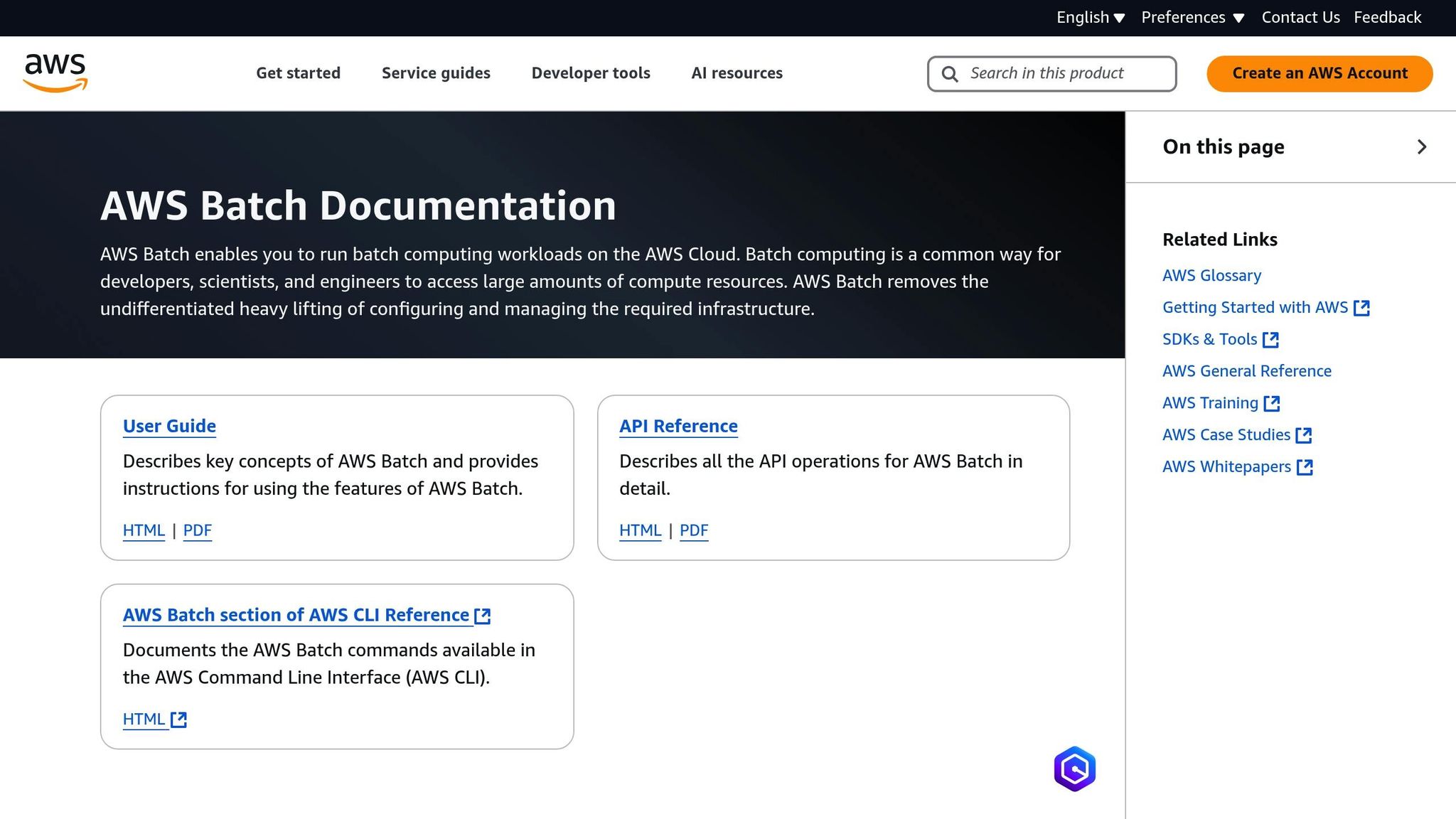
1. Review Current Batch Processing Setup
Before scaling AWS Batch jobs, take a close look at your current batch processing setup. This helps pinpoint bottlenecks and ensures your workloads can handle increased demand.
1.1 Check Job Queue Performance
Keep an eye on your AWS Batch job queue metrics to understand performance:
- Queue Processing Time: Measure how long jobs take to complete on average.
- Queue Depth: Observe the number of pending jobs to identify capacity issues.
- Resource Utilisation: Analyse CPU, memory, and storage usage across compute environments.
Use CloudWatch to track key metrics like:
- Job success rates
- Average queue wait times
- Efficiency of resource allocation
- Trends in job completion
1.2 Check Resource Limits
Evaluate your AWS service quotas and resource limits to avoid scaling issues. Here's a quick reference:
| Resource Type | Standard Limit | Recommended Action |
|---|---|---|
| EC2 On-Demand Instances | 20 per region | Request a limit increase if usage exceeds 70%. |
| EBS Volume Count | 5,000 per account | Regularly monitor volume usage trends. |
| AWS Batch Job Queues | 50 per region | Consider consolidating queues if applicable. |
| VPC Endpoints | 50 per region | Review endpoint usage to ensure efficient access. |
1.3 Check SLA Compliance
Ensure your batch jobs meet service level agreements (SLAs). Focus on these areas:
- Processing Windows: Confirm jobs finish within the required timeframes.
- Resource Efficiency: Review how resources are being used.
- Error Management: Monitor error rates and recovery times.
Establish baseline metrics, such as:
- Job completion rates
- Resource utilisation
- Cost per job execution
- Error rates
Set up CloudWatch alarms to track these metrics and ensure scaling efforts maintain - or improve - performance levels.
Once you've reviewed these elements, move on to optimising your compute environment to align with these findings.
2. Set Up Compute Environment
Prepare your compute environment to ensure it delivers consistent performance, reliability, and cost savings.
2.1 Configure Multi-AZ Setup
Spread your compute resources across multiple Availability Zones (AZs) to reduce downtime and improve fault tolerance. For the London (eu-west-2) region, you can organise resources as follows:
| Configuration | Example Setting | Purpose |
|---|---|---|
| Primary AZ | eu-west-2a | Main processing zone |
| Secondary AZ | eu-west-2b | Backup for failover |
| Tertiary AZ | eu-west-2c | Extra layer of redundancy |
| Instance Distribution | Even spread | Workload balancing |
| AZ Failover | Automatic | Maintain service continuity |
2.2 Use Spot Instances
Spot Instances help cut costs while keeping jobs reliable. When setting up a Spot Fleet, aim for a balance between affordability and availability.
Key tips include:
- Spot Fleet Settings: Use a diverse fleet, set a price cap relative to On-Demand rates, define your target capacity, and mix instance types for flexibility.
- Interruption Handling:
- Plan for potential interruptions.
- Enable automatic checkpointing to save progress during disruptions.
- Implement retry logic to ensure jobs can resume smoothly.
2.3 Select Instance Types
Choose instance types that match your workload's needs. To get the best results:
- Stick to instance types from the same generation within your setup.
- Enable enhanced networking for better data throughput.
- Use placement groups for workloads that require high network performance.
- Set termination policies based on job priorities to handle disruptions effectively.
Once your compute environment is ready, you can move on to defining batch job parameters.
3. Set Up Batch Job Definitions
Adjust job retry settings to reduce failures and avoid wasting resources.
3.1 Set Up Job Retries
To ensure reliable batch processing, use the following retry configurations:
- Set a maximum retry limit: Aim for 3 to 5 attempts.
- Introduce delays between retries: Wait 60 to 180 seconds before retrying.
- Apply exponential backoff: Gradually increase the delay after each failed attempt.
- Specify retry conditions: Retry on temporary issues like network timeouts, but stop immediately for errors like permission denials.
Fine-tune these settings to finalise your batch job definitions before moving on to other configurations.
4. Set Up Auto-Scaling
Auto-scaling helps your system adjust its compute capacity automatically based on workload demands. This ensures efficient resource use while keeping costs under control. Start by defining the metrics that will trigger scaling actions.
4.1 Set Scaling Metrics
Here are some key metrics to monitor:
- vCPU utilisation: Helps identify when processing demand is high.
- Job queue depth: Highlights backlogs in your system.
- Memory utilisation: Ensures there's enough capacity for smooth operation.
- Job wait times: Flags delays in processing tasks.
Set up CloudWatch alarms to respond to these metrics. Add cooldown periods to avoid constant scaling adjustments that could destabilise your system.
5. Monitor Performance and Costs
Keep an eye on performance and costs to spot issues and make better use of resources.
5.1 Set Up CloudWatch
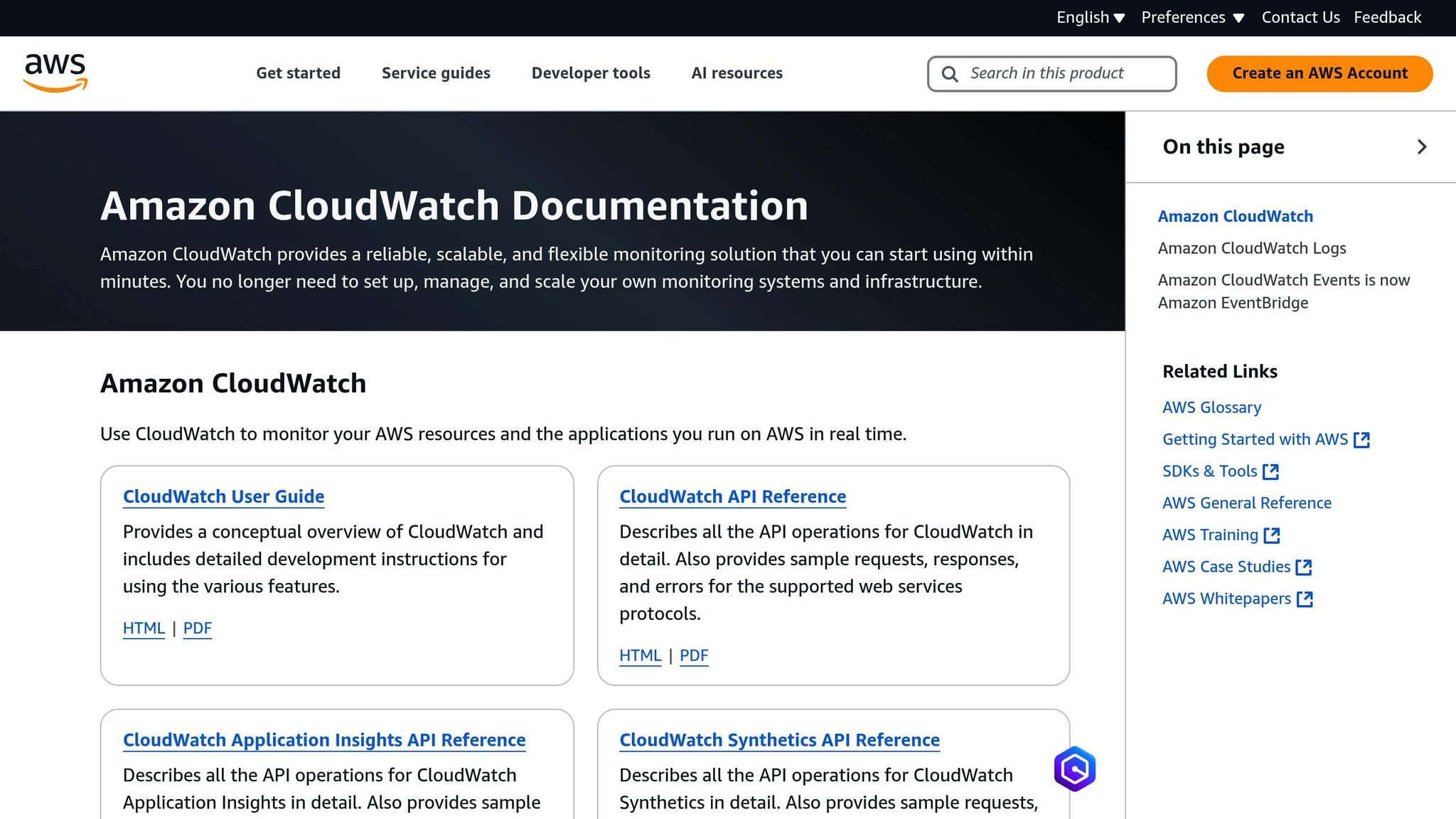
Use CloudWatch to track key metrics such as:
- Job Success Rate: The percentage of jobs completed successfully.
- Queue Processing Time: The average time jobs spend waiting in queues.
- Resource Usage: Monitor CPU, memory, and storage utilisation.
- Cost per Job: Calculate the cost of resources for each batch process.
Set up CloudWatch dashboards to view metrics in real-time and create alerts for critical thresholds. This data helps you manage costs more effectively, as explained in the next section.
5.2 Apply Cost-Saving Measures
Here are some ways to manage costs:
-
Instance Strategy:
- Use Spot Instances to save money.
- Reserve instances for predictable workloads.
- Use On-Demand instances for high-priority tasks.
-
Resource Tagging:
- Tag resources by department to track usage.
- Monitor project-specific costs.
- Keep an eye on spending across environments like development, staging, and production.
- Scheduling Adjustments: Run batch jobs during off-peak hours to take advantage of lower Spot Instance prices and reduce competition for resources.
5.3 Monitor Resource Quotas
Regularly check resource quotas to avoid disruptions:
| Resource Type | Alert Threshold | Recommended Action |
|---|---|---|
| EC2 Instance Limits | 80% of quota | Request a quota increase |
| EBS Volume Count | 85% of quota | Archive unused volumes |
| Batch Job Queue Depth | 90% of capacity | Scale the compute environment |
Set up CloudWatch alerts for when these thresholds are exceeded. Review and adjust quotas as needed to maintain smooth operations.
For more tips on saving costs with AWS, check out AWS Optimization Tips, Costs & Best Practices for Small and Medium sized businesses.
6. Implement Security Measures
When scaling AWS batch jobs, it's crucial to put strong security measures in place. After addressing performance and cost considerations, securing your environment ensures it remains dependable.
6.1 Set Up IAM Roles
Assign specific IAM roles to your batch jobs, following the principle of least privilege:
| Role Type | Required Permissions | Purpose |
|---|---|---|
| AWS Batch Service Role | AWSBatchServiceRole | Manages AWS resources for Batch |
| Job Role | S3 Read/Write, ECR Pull | Grants jobs access to necessary resources |
| Compute Environment Role | EC2InstanceRole | Allows EC2 instances to interact with AWS services |
To further limit access, narrow down S3 permissions as shown below:
{
"Version": "2012-10-17",
"Statement": [
{
"Effect": "Allow",
"Action": ["s3:GetObject", "s3:PutObject"],
"Resource": "arn:aws:s3:::your-batch-bucket/*"
}
]
}
6.2 Enable Data Encryption
Protect your data by encrypting it both at rest and in transit:
-
Data at Rest:
- Enable EBS encryption for storage volumes used in jobs.
- Use AWS KMS keys to encrypt S3 buckets.
- Encrypt temporary storage with keys tied to specific instances.
-
Data in Transit:
- Use TLS 1.2 or higher for API communications.
- Set up VPC endpoints for secure access to AWS services.
- Ensure HTTPS is used for all job-related communications.
6.3 Configure Network Security
Apply network-level safeguards to protect your batch environment:
| Security Control | Configuration | Purpose |
|---|---|---|
| VPC Flow Logs | Enable logging to CloudWatch | Monitor and analyse network traffic patterns |
| Security Groups | Restrict inbound ports | Manage access to your resources |
| Network ACLs | Block high-risk CIDR ranges | Add an extra layer of protection |
For security group rules, tailor them to your batch workloads:
Inbound Rules:
- Allow TCP 443 (HTTPS) traffic within your VPC CIDR.
- Permit custom ports required for job communication.
Outbound Rules:
- Allow connections to AWS service endpoints.
- Permit access to job-specific external endpoints.
Additionally, set up VPC endpoints for S3 and ECR. Update your route tables and security groups to align with these configurations. Incorporating these security practices into your AWS batch setup will help create a safer and more reliable environment.
7. Test Scaling Setup
Once your compute and security configurations are in place, thorough testing ensures your system is ready to scale effectively.
7.1 Run Gradual Tests
Start with small-scale tests that reflect everyday conditions, then slowly increase the load to identify performance bottlenecks. Use tools like CloudWatch alerts to track essential metrics, building on your existing monitoring setup. Also, check how well your environment handles interruptions in Spot Instances.
7.2 Test Spot Handling
Evaluate your system’s ability to manage Spot interruptions by simulating scenarios such as:
- Gradual termination of some Spot Instances.
- Sudden interruption of multiple Spot Instances at once.
- An Availability Zone outage affecting both Spot and On-Demand Instances.
These tests help ensure your system can recover and continue functioning smoothly, even under challenging conditions.
7.3 Test Peak Performance
Push your system to its limits by simulating maximum load conditions. Test how it performs during sustained high demand and sudden spikes. Keep an eye on job processing times and resource usage, including memory, network throughput, and storage. Make sure everything stays within acceptable limits. Use the findings to fine-tune your scaling approach.
Conclusion: SMB Scaling Checklist Summary
To scale AWS batch jobs effectively, focus on compute optimisation, thorough monitoring, and strong security measures. Use a mix of instance types and spread workloads across multiple Availability Zones, keeping an eye on performance with CloudWatch. Strengthen security by implementing IAM policies and encrypting your data.
Test your scaling setup rigorously, especially for handling Spot Instances and high-demand scenarios. Regular testing can help identify and address bottlenecks. Stay on top of AWS quotas and resource limits to ensure your setup evolves alongside your processing needs.
Make sure your auto-scaling strategy strikes the right balance between cost-efficiency and performance to handle fluctuating workloads. Use checkpointing to safeguard data during interruptions, and fine-tune job queues to prioritise essential tasks.
Lastly, keep monitoring both performance and costs to identify new ways to streamline operations. Following this checklist will help ensure your AWS batch jobs run efficiently, securely, and within budget.
FAQs
How can I scale AWS batch jobs efficiently while keeping costs under control?
To scale AWS batch jobs efficiently and cost-effectively, focus on optimising resource usage and leveraging AWS features designed for scalability. Start by using Auto Scaling to adjust resources dynamically based on workload demands. Choose cost-efficient instance types, such as Spot Instances, for non-critical tasks to reduce expenses.
Additionally, monitor and analyse costs regularly using AWS tools like Cost Explorer or Budgets to identify savings opportunities. Efficiently managing storage, minimising idle resources, and automating workflows can also significantly reduce costs while ensuring smooth scaling. Prioritising these strategies will help you maintain performance without overspending.
How can I effectively manage interruptions when using AWS Spot Instances?
To handle interruptions with AWS Spot Instances effectively, you can implement a few key strategies. Use Spot Instance interruption notices to detect when an instance is about to be terminated, giving you up to two minutes to gracefully stop or migrate your workload. Additionally, consider using Spot Fleet or EC2 Auto Scaling groups with mixed instance types and purchasing options to improve availability and minimise disruptions.
To further reduce risks, ensure your applications are designed to be fault-tolerant and can recover quickly. For example, you can use Amazon S3 or Amazon DynamoDB for data persistence and decouple workloads with Amazon SQS or Amazon SNS. By combining these approaches, you can optimise costs while maintaining resilience in your batch processing jobs.
How can I ensure security while monitoring and scaling batch jobs on AWS?
To maintain security when scaling batch jobs on AWS, it's essential to follow best practices for monitoring and protection. Use AWS CloudWatch to track the performance and health of your batch jobs, and enable AWS CloudTrail to monitor API activity and detect unauthorised actions. Regularly review and update your IAM roles and permissions to ensure that only authorised users have access to critical resources.
Additionally, implement encryption for sensitive data, both at rest and in transit, and configure VPC security groups to control network traffic. For SMBs, optimising these practices can help maintain both security and cost efficiency while scaling workloads.

